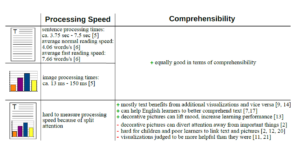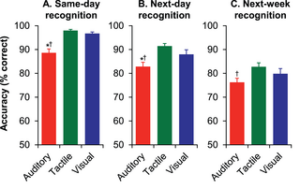“Vision science” is an amalgam of information from multiple disciplines with multiple points of focus. From the world of eyewitness identification we know two fundamental principles. The first is that the mind is not a video camera: it captures only portions of the incoming data and what it does capture does not remain intact as there are no “flashbulb memories” that remain permanently and unaltered. The second is that memory can easily be altered, simply by asking a question of the perceiver. If you ask a robbery victim “did the perp have a mustache” instead of “tell me, as best you can, what you remember about the face of the robber” the memory might ‘grow’ a hairy upper lip. [For more on this see https://law.temple.edu/aer/2021/09/02/brain-lessons-do-you-see-the-duck/ ]
But those two lessons – the incompleteness and impermanence of a memory – are lessons for questioning witnesses or understanding the limits of an eyewitness account of any event. What about juror perception and memory and vision or ‘visual’ science in the courtroom?
There are some scientific principles with a sound foundation, principles we may need as we teach more effective use of visual presentation. Here are several.
The first is simple. Humans process visuals quicker than they process words. A visual image can be processed [recognized for what it is] in 13 milliseconds. https://www.livescience.com/42666-human-brain-sees-images-record-speed.html (last visited December 13, 2023). The foundational research is in Potter, M.C., Wyble, B., Hagmann, C.E., & McCourt, E.S. (2014). Detecting meaning in RSVP at 13 ms per picture. Attention, Perception, and Psychophysics.
But how fast do humans process words? Before you shout out “60,000- times slower than pictures,” a claim often found online (see, e.g., https://www.learnevents.com/learning-insights/imagery-vs-text-which-does-the-brain-prefer/ , claiming that “90% of information transmitted to the brain is visual, and visuals are processed in the brain at 60,000 times the speed of text.”), be aware that here there is a dearth of science and in fact some contrary research. More conservative (and research based) estimates suggest that images are processed 6 to 600 times faster than text. Tuscher, Processing Speed and Comprehensibility of Visualizations and Texts. Tuscher created the following graphic:

The reference to “split attention” is the next visual proof data point. This has been conceptualized as the “dual channel” mode of information processing – one part of the brain processes visual/spatial material and the other processes auditory/verbal material. See Mayer, MULTIMEDIA LEARNING, THIRD EDITION. Thus, be careful when using a visual with pictures and words; and if there is a visual with words [e.g. a jury instruction excerpt] let the jurors read them without you reciting them aloud. The result can be processing overload which hinders comprehension and retention.
And retention is maybe most important. The following was reported in the Proceedings of the National Academy of Sciences:
[V]isual memory for scenes is very robust. In the most dramatic demonstration, Standing showed observers up to 10,000 images for a few seconds each and reported that they could subsequently identify which images they had seen before with 83% accuracy. This memory is far superior to verbal memory and can persist for a week.
Cohen et al., Auditory recognition memory is inferior to visual recognition memory (April, 2009), https://www.pnas.org/doi/10.1073/pnas.0811884106 (last visited December 14, 2023).
One study captured these results by testing for fact recall after receiving information in auditory, tactile or visual form:

Bigelow and Poremba: Achilles’ Ear? Inferior Human Short-Term and Recognition Memory in the Auditory Modality, PLOS One (February 26, 2014) https://journals.plos.org/plosone/article?id=10.1371/journal.pone.0089914 (last visited December 15, 2023).
There is more known about retention. There is research showing that retention will be greater when images are narrated [explained] by spoken word than by having an accompanying written explanation on screen. This is called the “modality effect.” Richard E. Mayer & Roxana Moreno, Nine Ways to Reduce Cognitive Load in Multimedia Learning, 38(1) Educational Psychologist 43 (2003).
What does all of this tell us? Visuals are important, visuals are quickly identified by the brain, visuals with text may be a problem especially if counsel reads aloud while jurors are trying to do the same, and properly used visuals are important for fact retention. The remaining concern is visual overload – when is the point where retention drops because too many pictures were shown?
The answer here comes from cognitive load – the amount of information the brain can hold. The maximum number of visual inputs the mind can hold at one time in working memory is four, so adding more causes loss of the fact(s) in one of the first four images. Burgess, Deepening the Discourse Using The Legal Mind’s Eye: Lessons From Neuroscience And Psychology That Optimize Law School Learning, 28 QLR 1, 27 (2011). See also, G.A. Alvarez & P. Cavanagh, The Capacity of Visual Short-Term Memory Is Set Both by Visual Information Load and by Number of Objects, 15(2) Psycho. Sci. 106 (2004) The Alvarez article makes two compelling points – there is an overall limit on the number of images that can be stored in memory; and the more complex [detailed] the image, the less capacity to store multiple ones.
So – what are some science takeaways? Unlike Othello, use visuals not too well but wisely. Few, narrated without writing, and simple.
